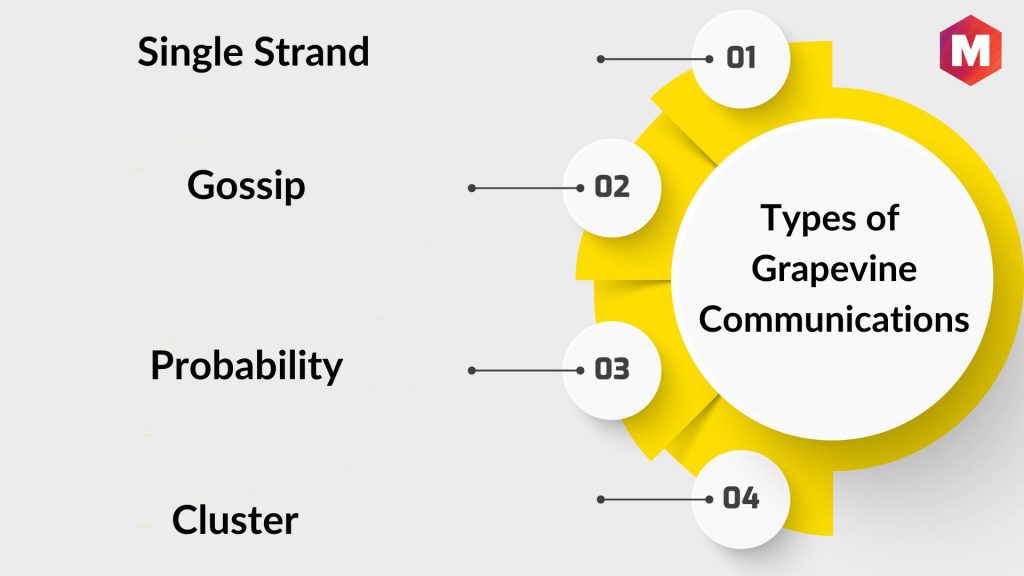
The Essential Guide to Grapevine Communication: Types, Importance, and Differences

Grapevine communication is an informal network used by employees to share information It can be beneficial for organizations if managed correctly, but can also lead to misunderstandings and rumors There are different types of grapevine communication, including single strand, gossip, probability, and cluster Handling and utilizing grapevine communication effectively can benefit any organization
In an organization, grapevine communication refers to an informal network that employees use to share information with each other. This type of communication can travel in all directions - up, down, sideways, and diagonally - and typically operates outside of the formal channels of communication within the organization.
Grapevine communication is a complex web of gossip, rumors, and official information that interconnects various networks. According to research, work-related rumors make up around 80% of grapevine communication, while personal gossips account for the remaining 20%.
Typically, an employee can belong to multiple grapevine networks, with minimal interaction between them, except for informal communication through fellow colleagues.
What is Grapevine Communication?
In order to optimize the use of information communication, it is essential to understand the correct approach for your organization. With that in mind, let's dive into the best practices for utilizing this valuable tool.
Effective communication is a vital aspect of any successful organization. Within an organization, communication can take two forms: formal and informal. Informal communication, also known as grapevine communication, involves the sharing of information in a non-predefined manner, often occurring randomly.
The importance of grapevine communication cannot be overstated in any organization. Informal communication between employees and authorities is a vital aspect of day-to-day operations, which is why grapevine communication is essential. This type of communication is not limited in scope, which is why it is called grapevine. To better understand its significance, it is important to examine the various types of grapevine communication.
Importance of Grapevine Communication
Informal communication, known as grapevine communication, is a crucial method that relies on emotions and feelings. In any organization, regardless of its size, grapevine communication holds immense significance. As social creatures, humans have an innate desire to communicate with others. However, speaking formally all the time can become tedious. Therefore, grapevine communication serves as an excellent informal alternative.
Grapevine communication is beneficial in enhancing interpersonal relationships within an organization. It promotes a friendly environment between employees and authorities, which ultimately leads to increased efficiency and productivity of employees.
Informal communication through grapevine can be a valuable tool for employees to calm their emotions and connect with colleagues. This type of communication also facilitates the sharing of essential messages that are necessary for the organization's proper functioning. For instance, a secretary may hold crucial information from senior management that can be communicated informally through the grapevine to ensure smooth operations. Additionally, grapevine communication is known for its rapid information dissemination, making it an effective means of sharing important messages.
Gregarious individuals are prevalent in all settings, a fact that cannot be refuted. To satisfy their need to converse, grapevine communication is often utilized. This type of communication is not only beneficial for employee morale, but it is also encouraged by organizations as a means of enhancing overall productivity.
Types of Grapevine Communications
Grapevine communication has been categorized into four subsets
1. Single strand
In this form of communication, the information is transmitted to a trustworthy person who further transfers it to another trustworthy person hence forming a chain.
2. Gossip
3. Probability
This form of communication, known as gossip, involves sharing fascinating information with a group of individuals. Unlike work-related discussions, the conversation primarily revolves around interesting topics that may not have any connection to work.
The individual transmitting the information in the probability chain is uncertain about whom to convey the information to, as there are numerous individuals in their vicinity. As a result, they may pass on the information haphazardly to someone who then proceeds to pass it on randomly to others. This mode of communication does not involve a deliberate selection of the recipient.
4. Cluster
This type of communication involves selectively sharing information with certain individuals who are expected to pass it on to others. The purpose of this type of communication is to gain a favor from the ultimate receiver of the information.
In this type of communication, the recipient is chosen and there is no random transmission observed. These are the four categories of informal or grapevine communication that are present in a company.
Here is a video byon how to manage grapevine communication and utilize grapevine for business communication too.
What are Some Disadvantages of Grapevine Communication?
1. Rumors and not fact-based
Information that spread in grapevine communication is often based on rumors and is mostly incomplete information.
Hence the interpretation of the information can be distorted, which could be detrimental for the organization.
2. Information spreads quickly
Grapevine communication has both pros and cons, and one of them is the speed at which rumors spread throughout the organization. However, if the information being spread is inaccurate or inappropriate, it can lead to disastrous consequences.
3. Misunderstanding and emotional breakdown
When communication lacks formal rules, misunderstandings are more likely to occur. Additionally, if the information being conveyed is emotionally harmful for an individual, it can result in a breakdown of their emotional well-being.
Since the information is often incomplete and lacks factual support, it increases the likelihood of misunderstandings. This type of communication can have negative emotional consequences, potentially leading to a toxic work culture within the organization. This is clearly not a desirable outcome.
4. Almost no secrecy
Open discussions are the primary mode of communication in grapevine, which makes maintaining secrecy challenging. Additionally, the lack of rules and regulations governing grapevine communication makes it impossible to control the flow of information. These inherent drawbacks of grapevine communication highlight the need to exercise caution when sharing information, as it can have both positive and negative consequences for the organization.
Let us see how an organization can develop a positive grapevine communication culture for increasing productivity.
Examples of Grapevine Network of Communication
In the workplace, grapevine communication takes place when employees engage in discussions about the company or their colleagues. Whether positive or negative, this informal method of communication is constantly occurring and can significantly impact team dynamics. Therefore, it is crucial for managers to understand the effects of grapevine communication on their team and take appropriate measures accordingly.
Fragment 26: A common example of grapevine communication in the workplace is when an individual perceives unfair treatment and shares their grievances with colleagues, potentially leading to the spread of rumors and gossip that further exacerbate the situation.
27) On the other hand, if a new hire shares the same values as the company culture, they are more likely to fit in and feel welcomed by their colleagues. This can create a positive work environment and increase productivity.
4) An employee is fired and the grapevine starts to talk about why. This can lead to gossip chain or rumor-mongering, which can make a situation worse than it already is.
How to Handle Grapevine Communication at Work?
Managing grapevine communication in the workplace can be challenging, as it can either positively or negatively impact employee morale and productivity. While grapevine communication can sometimes provide valuable information, it can also lead to rumors and gossip. To effectively handle grapevine communication, it is essential to establish open and transparent communication channels, encourage employees to share their concerns and questions, and address any misinformation or rumors promptly. Additionally, providing regular updates on important business matters can help reduce the spread of inaccurate information and promote a culture of trust and collaboration.
Pay attention to what’s being said around you and be mindful of the impact your words could have on others. If you hear something you don’t understand or that seems important, ask for clarification rather than spreading rumors or gossiping about colleagues. Remember that creating a positive and respectful workplace environment is everyone’s responsibility.
Try to avoid making assumptions or spreading rumors about other employees or departments. If someone asks you a question that you don't know the answer to, it's better to simply say "I don't know" rather than providing inaccurate information that could cause confusion or harm. Remember, speculation can often lead to misunderstandings and it's always better to err on the side of caution.
How to Make Grapevine Communication Beneficial for an Organization?
It is crucial for the authorities within an organization to have a hand in shaping the grapevine communication. This entails ensuring that those who start the grapevine have access to accurate information.
If managers want to make use of the grapevine, they can identify those who actively initiate it and keep an eye on the information they share. In case any false information is spread, managers should intervene quickly and provide facts and trustworthy information to counteract it. This can be accomplished through formal channels. Additionally, managers can use the grapevine to gather feedback from employees and improve the organization. Therefore, managers should encourage and promote the grapevine ecosystem.
Managers must actively engage with their employees and involve them in the decision-making process to ensure they have access to accurate, fact-based information. The culture and atmosphere of the organization are critical factors in this process. Without a sense of respect and mutual understanding, the grapevine will never produce positive results. Therefore, organizations must prioritize the development of a healthy and supportive climate.
Final words!
It is important for grapevine communication to disseminate accurate information in a controlled manner in order to positively impact a company's productivity. In the event that anything goes awry, it is necessary for authorities to step in and address the situation. Encouraging grapevine communication can help cultivate a more amicable working environment within the organization.
Recruiters, managers, and business owners must prioritize effective communication during times of change. It is crucial to ensure that official information is communicated through formal channels before any informal messages start circulating through the grapevine. However, employees also have a responsibility to actively seek confirmation of informal messages through formal channels. By utilizing this approach, organizations can expect positive outcomes.
Do you have any instances of grapevine communication in your organization that you would like to share here?

















